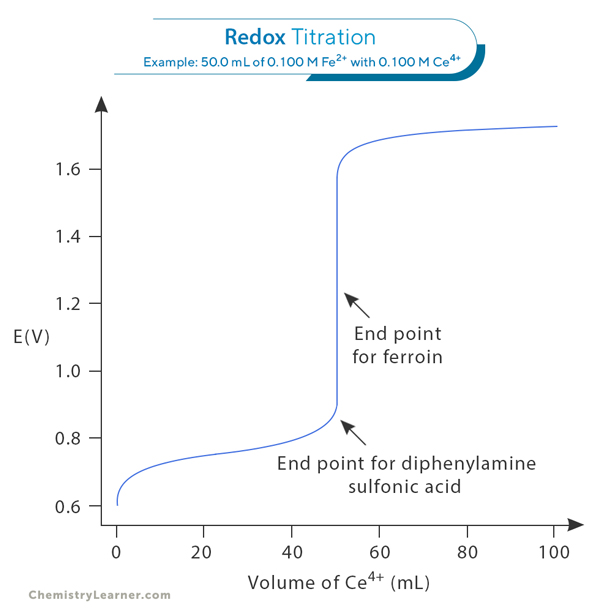Redox Titration
Redox titration is used in analytical chemistry to determine and quantify substances precisely based on their oxidation-reduction reactions. This method relies on the transfer of electrons between reactants, where one compound undergoes oxidation (loses electrons) while the other undergoes reduction (gains electrons). The concentration or content of the analyte can be accurately calculated by carefully measuring the amount of reagent required to complete the reaction.
Examples
Here are a few examples of redox titrations, along with their corresponding chemical equations:
1. Iron (II) with Potassium Permanganate
Fe2+ + MnO4– + 8 H+ → Fe3+ + Mn2+ + 4 H2O
Iron (II) ions are titrated with potassium permanganate (KMnO4) in an acidic medium. Potassium permanganate is the oxidizing agent, oxidizing iron (II) to iron (III). The endpoint is signaled by a color change from pink, due to the permanganate ion, to a light yellow or brown, indicating the excess potassium permanganate.
2. Sodium Thiosulfate with Iodine
2 S2O32- + I2 → S4O62- + 2 I–
Sodium thiosulfate (Na2S2O3) is titrated with iodine (I2). In the presence of a suitable indicator, the iodine oxidizes thiosulfate ions to tetrathionate ions. The disappearance of the iodine solution’s blue-black color signifies the reaction’s endpoint.
3. Hydrogen Peroxide with Potassium Permanganate
5 H2O2 + 2 MnO4– + 6 H+ → 5 O2 + 2 Mn2+ + 8 H2O
Hydrogen peroxide (H2O2) is titrated with potassium permanganate in an acidic medium. Potassium permanganate acts as an oxidizing agent, oxidizing hydrogen peroxide to oxygen gas and water. A color change in the solution typically detects the endpoint.
Procedure
Consider a solution containing iron (II) ions titrated with potassium dichromate (K2Cr2O7) solution under acidic conditions. The potassium dichromate is the oxidizing agent, while iron (II) is the reducing agent. A suitable indicator, diphenylamine or ferroin, is added to detect the reaction’s endpoint.
Initially, a known volume of iron (II) solution is placed in a titration flask. A few drops of the chosen indicator are added, giving a color change to the solution. The potassium dichromate solution is slowly added from a burette into the flask, continuously swirling. The potassium dichromate oxidizes iron (II) to iron (III), causing the indicator’s color to change permanently. At the endpoint, the indicator’s appearance signifies the reaction’s completion. The volume of potassium dichromate solution required to reach the endpoint is noted for subsequent calculations to determine the concentration of the iron (II) solution.
In this process, the solution containing Cr2O72- is introduced to the Fe2+ solution. As the Fe2+ is oxidized to Fe3+, the dichromate ion undergoes reduction to form Cr3+. The following chemical reaction can represent the entire process:
2 Cr2O72- + 14 H+ + 6 Fe2+ → 2 Cr3+ + 6 Fe3+ + 7 H2O
Indicators
Indicators are pivotal in signaling a reaction’s endpoint and marking the oxidation-reduction process’s completion. Various indicators are employed, each selected based on specific criteria to ensure accurate and precise endpoint detection. The choice of indicator is crucial, as it directly influences the reliability of the titration results.
Several critical factors guide the selection of indicators in redox titrations. Primarily, the indicator should exhibit a sharp and distinct color change at or very close to the equivalence point of the reaction. Additionally, the indicator’s color change must be visible against the reaction’s background color, ensuring accuracy in determining the endpoint. Furthermore, the indicator’s chemical interaction with the reactants and products should not interfere with the reaction’s stoichiometry.
Common indicators utilized in redox titrations include organic dyes and compounds sensitive to changes in oxidation states. For instance, diphenylamine is often employed in titrations involving iron (II) oxidation due to its characteristic color change upon forming iron (III). Ferroin, another widely used indicator, undergoes a distinct color alteration between oxidized and reduced states, making it suitable for redox reactions involving transition metals.
The image below shows a redox titration curve using diphenylamine sulfonic acid and ferroin as indicators. Arrows indicate the endpoints.
Applications
The importance of redox titration extends across diverse scientific domains. Its precision and reliability find applications in pharmaceuticals, environmental analysis, and industrial processes. In pharmaceuticals, redox titration aids in quality control, ensuring the potency and purity of medications by quantifying active ingredients or identifying impurities. Environmental scientists leverage this technique to monitor pollutants in water or air, measuring levels of oxidizing or reducing agents that might pose ecological risks. Industries rely on redox titration for quality assurance, whether in assessing the concentration of chemicals in manufacturing processes or ensuring the efficacy of cleaning agents.
